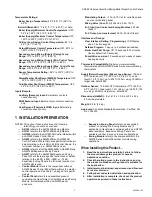
AQ252 Universal Injection/Mixing Boiler Reset Control Panels
3
69-1986—02
Temperature Ratings:
Boiler Design Temperature:
80°F to 210°F (26°C to
99°C)
Boiler Differential:
2°F to 41°F (1°C to 23°C), or Auto
Boiler (Supply) Minimum Control Temperature:
OFF,
59°F to 180°F (OFF, 15°C to 82°C)
Boiler (Supply) Maximum Control Temperature:
OFF,
120°F to 225°F (OFF, 49°C to 107°C)
Outdoor Low Design Control Temperature:
-60°F to
32°F (-51°C to 0°C)
Return Minimum Control Temperature:
OFF, 80°F to
180°F (OFF, 27°C to 82°C)
Secondary Loop Mixing (Supply) Design Temp
Range:
70°F to 210°F (21°C to 99°C)
Secondary Loop Mixing (Supply) Min. Control Temp
Range:
OFF, 35°F to 150°F (OFF, 2°C to 66°C)
Secondary Loop Mixing (Supply) Max. Control Temp
Range:
OFF, 80°F to 210°F (OFF, 27°C to 99°C)
Sensor Temperature Rating:
-58°F to 230°F (-50°C to
110°C)
Warm Weather Shut Down (WWSD) Temperature:
OFF,
35°F to 100°F (OFF, 1°C to 38°C)
Cold Weather Shut Down (CWSD) Temperature:
OFF,
32°F to 100°F (OFF, 0°C to 38°C)
Inputs/Outputs:
Auxiliary (Demand) Input:
External dry contacts
connection only
DHW Demand Input:
External dry contacts connection
only
Heat Demand (Thermostat R-W) Input:
External dry
contacts connection only
Modulating Output:
)-10 or 2-10 Vdc for variable speed
pump or modulating boiler
Mixing Valve (Com, O, C):
324 Vac, 0.5A, 12VA
R–C Input (on Control and Zoning Modules):
24 Vac
Class II
R–C Output (on transformer):
38 VA, 24 Vac Class II
Interface and Timings:
User Interface (Setting, Programming):
LCD Display
and a 7-button keypad
Setback Program:
7 day, up to 2 setback periods/day.
Boiler Heat Post Purge:
Off, 10 seconds to 30 minutes
(factory default is 30 seconds)
Pump/Valve exercise:
30 seconds per 2 weeks of space
heating inactivity
Thermostat Compatibility:
Digital non-communicating
thermostats and/or AQ1000 Series 2-wire communicating
thermostats
Supply/Return/Secondary (Mixed) Loop Sensor:
10K ohm
NTC thermistor at 77°F (25°C) ± 0.5°F (±0.3°C). Lead
length: 10 ft. (3.0 m); up to 500 ft. (150 m) using 18 AWG or
larger wire, beta=3892.
Outdoor Sensor:
10K ohm NTC thermistor at 77°F (25°C) ±
0.5°F (±0.3°C). Lead length: 15 ft. (4.6 m); up to 500 ft. (150
m) using 18 AWG or larger wire, beta=3892
Dimensions (HxWxD):
8 x 16 1/2 x 3 3/8 in. (20.3 x 42 x
8.5 cm) approximate
Weight:
4.9 lb. (2.3 kg)
Approvals:
Canadian Standards Association: Certified, File
No. LR76030
1 INSTALLATION PREPARATION
NOTES:
Throughout these instructions, the following
terminology conventions are used:
—
AQ155
refers to the AQ15540B Zoning Module.
—
AQ157
refers to the AQ15740B Zoning Module.
—
AQ1520
refers to the AQ15200B Control Module within
an AQ252 Series Control Panel.
—
AQ252
refers to the AQ25242B and AQ25244B
Control Panels. Where there are specific instructions or
details relating to the -42B or -44B Control Panels, the
full model number (i.e., AQ25244B) is used.
—
AQ255
refers to all of the AQ25542B, AQ25582B and
AQ25742B Expansion Zoning Panels.
—
AQ257
refers to the AQ25744B Expansion Zoning
Panel. Where there are specific instructions or details
relating to the -542B, -582B, -742B, or - 744B
Expansion Zoning Panels, the full model number (i.e.,
AQ25744B) is used.
—
Control Module
refers to the component within an
AQ252 Series Control Panel that performs the master
control operations. See Table 1 on page 2 for specific
models.
—
Control Panel
refers to an assembled product,
consisting of a transformer, Control Module and Zoning
Module, all contained within an AQ2000 panel
enclosure.
—
Expansion Zoning Panel
refers to an assembled
product, consisting of a Zoning Module and (if
applicable) a transformer, contained within an AQ2000
panel enclosure. Expansion Zoning Panels are
available in either 4-zone or 8-zone configurations.
—
Zoning Module
refers to the component within the
AQ252 Series Control Panel that controls zoning
operations.
When Installing this Product…
1.
Read these instructions carefully. Failure to follow
them could damage the product or cause a
hazardous condition.
2.
Check the ratings given in the instructions and on
the product to make sure the product is suitable for
the application.
3.
Installers must be trained, experienced, and licensed
service technicians.
4.
Follow local codes for installation and application.
5.
After installation is complete, check out the product
operation as printed in these instructions.
















